Organisational Culture and Behaviour: A Report on Morrisons
VerifiedAdded on 2023/01/03
|12
|3275
|1
Report
AI Summary
This report offers a comprehensive analysis of organisational behaviour within Morrisons, a major UK supermarket chain. It explores the company's organisational culture, including its types (power, role, task) and the influence of theories like Schein and Handy. The report examines communication strategies, including different types (verbal, non-verbal, written, visual) and models, highlighting their impact on employee interactions. Furthermore, it delves into motivational theories, such as Maslow's hierarchy of needs and Herzberg's two-factor theory, and their application within Morrisons. The report emphasizes the role of culture in shaping employee behaviour and its contribution to overall organisational success, providing valuable insights into leadership and management practices within the company. The report is designed to help students understand the key concepts of organizational behaviour. The report is contributed by a student and is available on Desklib, a platform providing AI-based study tools.
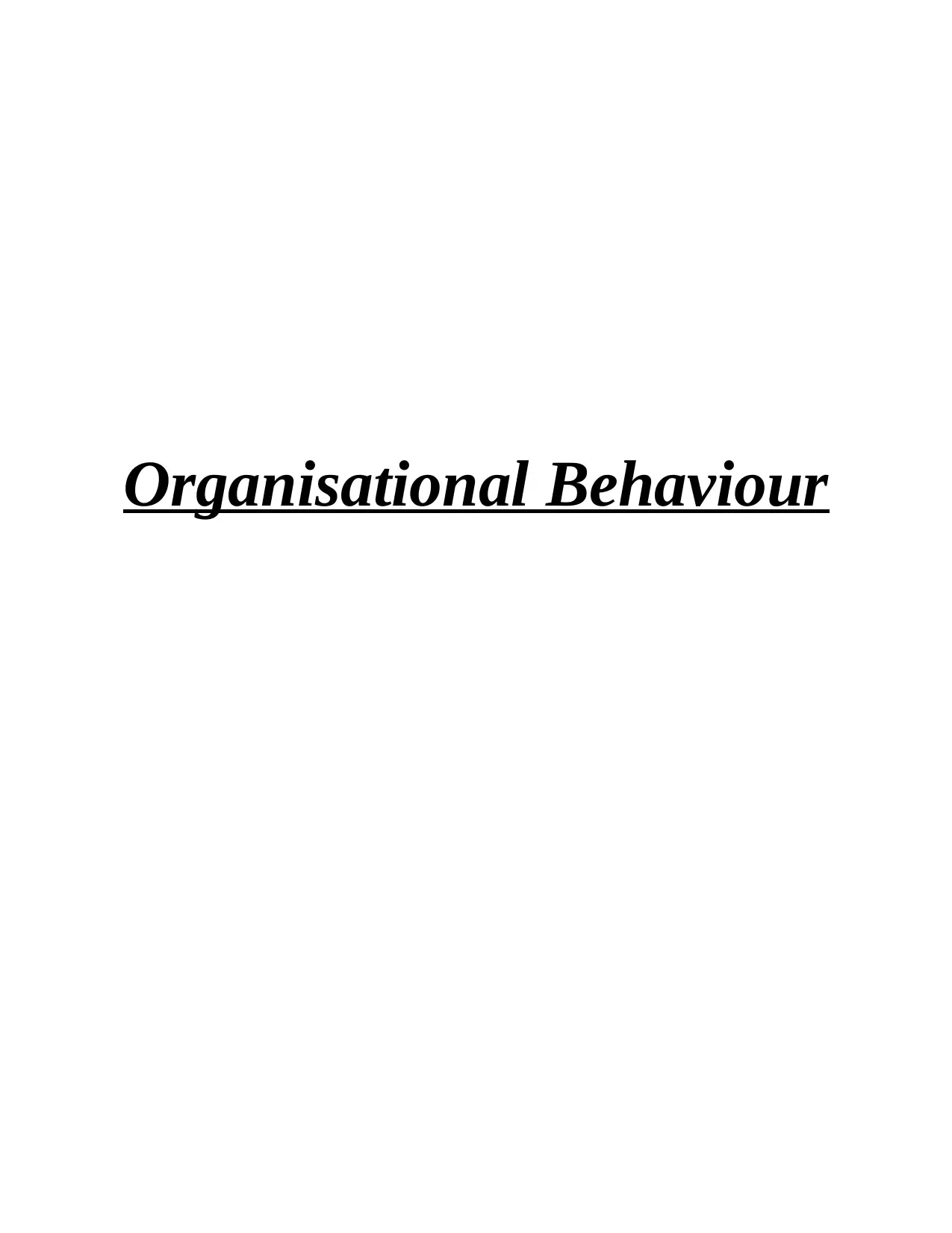
Organisational Behaviour
Paraphrase This Document
Need a fresh take? Get an instant paraphrase of this document with our AI Paraphraser
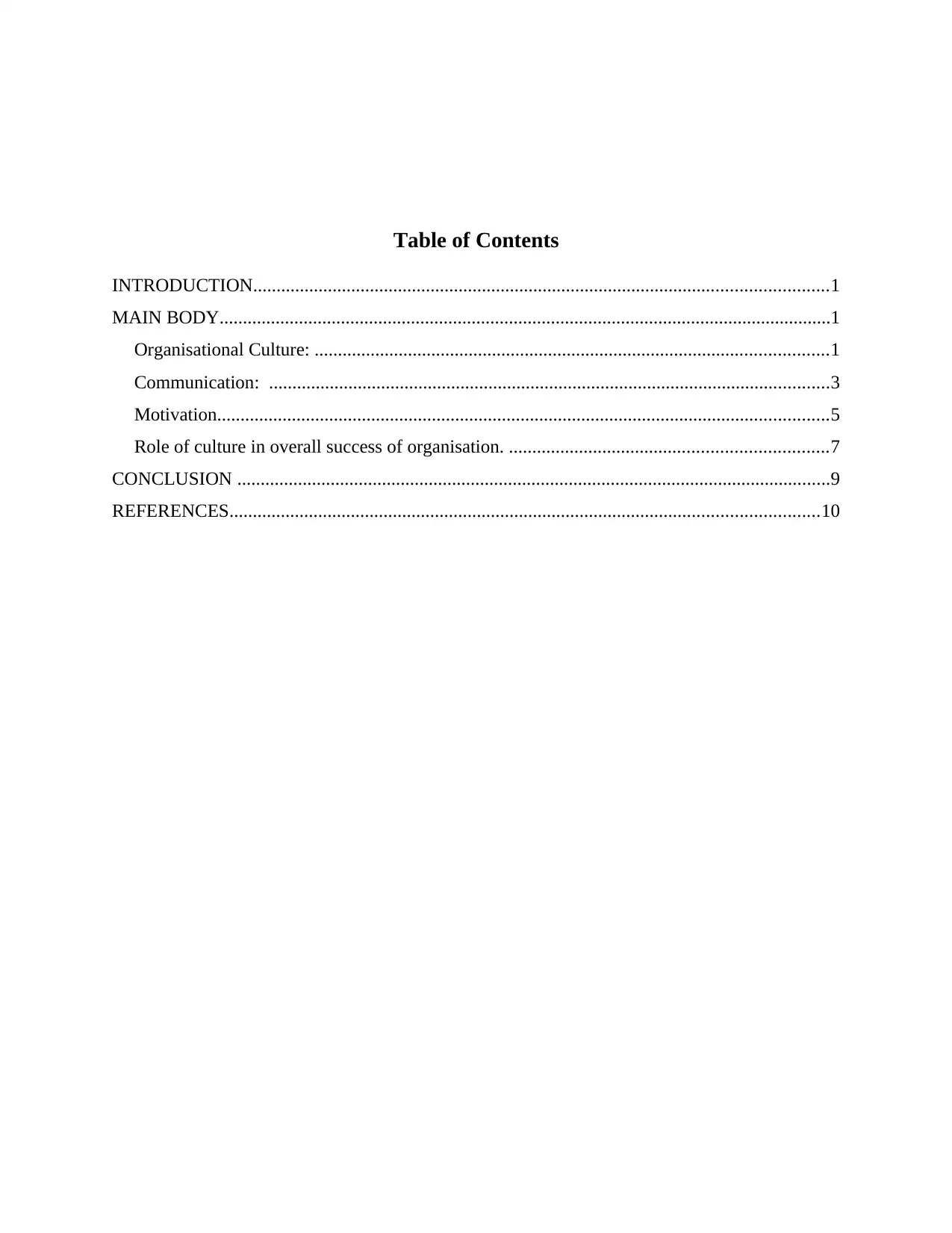
Table of Contents
INTRODUCTION...........................................................................................................................1
MAIN BODY...................................................................................................................................1
Organisational Culture: ..............................................................................................................1
Communication: ........................................................................................................................3
Motivation...................................................................................................................................5
Role of culture in overall success of organisation. ....................................................................7
CONCLUSION ...............................................................................................................................9
REFERENCES..............................................................................................................................10
INTRODUCTION...........................................................................................................................1
MAIN BODY...................................................................................................................................1
Organisational Culture: ..............................................................................................................1
Communication: ........................................................................................................................3
Motivation...................................................................................................................................5
Role of culture in overall success of organisation. ....................................................................7
CONCLUSION ...............................................................................................................................9
REFERENCES..............................................................................................................................10
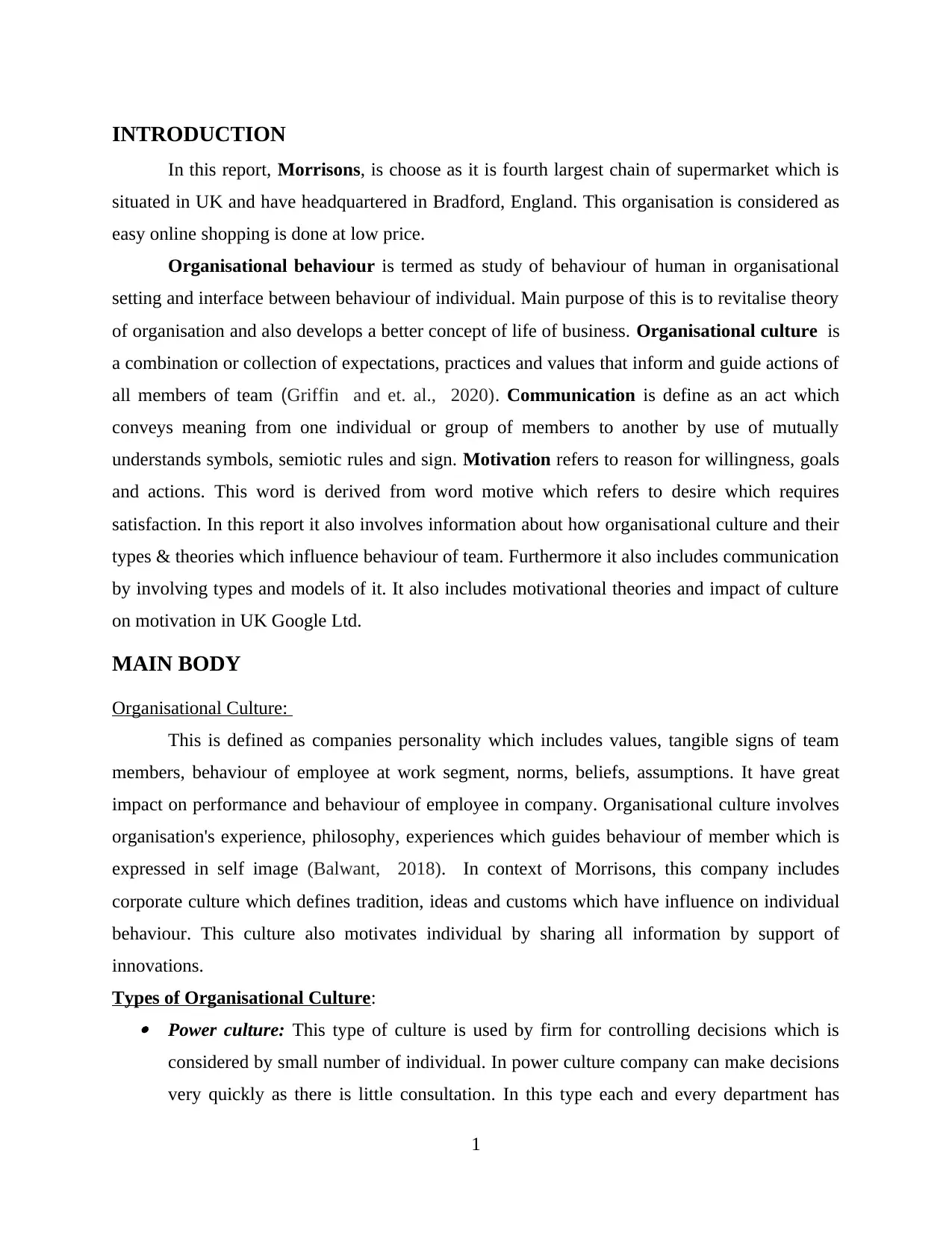
INTRODUCTION
In this report, Morrisons, is choose as it is fourth largest chain of supermarket which is
situated in UK and have headquartered in Bradford, England. This organisation is considered as
easy online shopping is done at low price.
Organisational behaviour is termed as study of behaviour of human in organisational
setting and interface between behaviour of individual. Main purpose of this is to revitalise theory
of organisation and also develops a better concept of life of business. Organisational culture is
a combination or collection of expectations, practices and values that inform and guide actions of
all members of team (Griffin and et. al., 2020). Communication is define as an act which
conveys meaning from one individual or group of members to another by use of mutually
understands symbols, semiotic rules and sign. Motivation refers to reason for willingness, goals
and actions. This word is derived from word motive which refers to desire which requires
satisfaction. In this report it also involves information about how organisational culture and their
types & theories which influence behaviour of team. Furthermore it also includes communication
by involving types and models of it. It also includes motivational theories and impact of culture
on motivation in UK Google Ltd.
MAIN BODY
Organisational Culture:
This is defined as companies personality which includes values, tangible signs of team
members, behaviour of employee at work segment, norms, beliefs, assumptions. It have great
impact on performance and behaviour of employee in company. Organisational culture involves
organisation's experience, philosophy, experiences which guides behaviour of member which is
expressed in self image (Balwant, 2018). In context of Morrisons, this company includes
corporate culture which defines tradition, ideas and customs which have influence on individual
behaviour. This culture also motivates individual by sharing all information by support of
innovations.
Types of Organisational Culture: Power culture: This type of culture is used by firm for controlling decisions which is
considered by small number of individual. In power culture company can make decisions
very quickly as there is little consultation. In this type each and every department has
1
In this report, Morrisons, is choose as it is fourth largest chain of supermarket which is
situated in UK and have headquartered in Bradford, England. This organisation is considered as
easy online shopping is done at low price.
Organisational behaviour is termed as study of behaviour of human in organisational
setting and interface between behaviour of individual. Main purpose of this is to revitalise theory
of organisation and also develops a better concept of life of business. Organisational culture is
a combination or collection of expectations, practices and values that inform and guide actions of
all members of team (Griffin and et. al., 2020). Communication is define as an act which
conveys meaning from one individual or group of members to another by use of mutually
understands symbols, semiotic rules and sign. Motivation refers to reason for willingness, goals
and actions. This word is derived from word motive which refers to desire which requires
satisfaction. In this report it also involves information about how organisational culture and their
types & theories which influence behaviour of team. Furthermore it also includes communication
by involving types and models of it. It also includes motivational theories and impact of culture
on motivation in UK Google Ltd.
MAIN BODY
Organisational Culture:
This is defined as companies personality which includes values, tangible signs of team
members, behaviour of employee at work segment, norms, beliefs, assumptions. It have great
impact on performance and behaviour of employee in company. Organisational culture involves
organisation's experience, philosophy, experiences which guides behaviour of member which is
expressed in self image (Balwant, 2018). In context of Morrisons, this company includes
corporate culture which defines tradition, ideas and customs which have influence on individual
behaviour. This culture also motivates individual by sharing all information by support of
innovations.
Types of Organisational Culture: Power culture: This type of culture is used by firm for controlling decisions which is
considered by small number of individual. In power culture company can make decisions
very quickly as there is little consultation. In this type each and every department has
1
⊘ This is a preview!⊘
Do you want full access?
Subscribe today to unlock all pages.

Trusted by 1+ million students worldwide
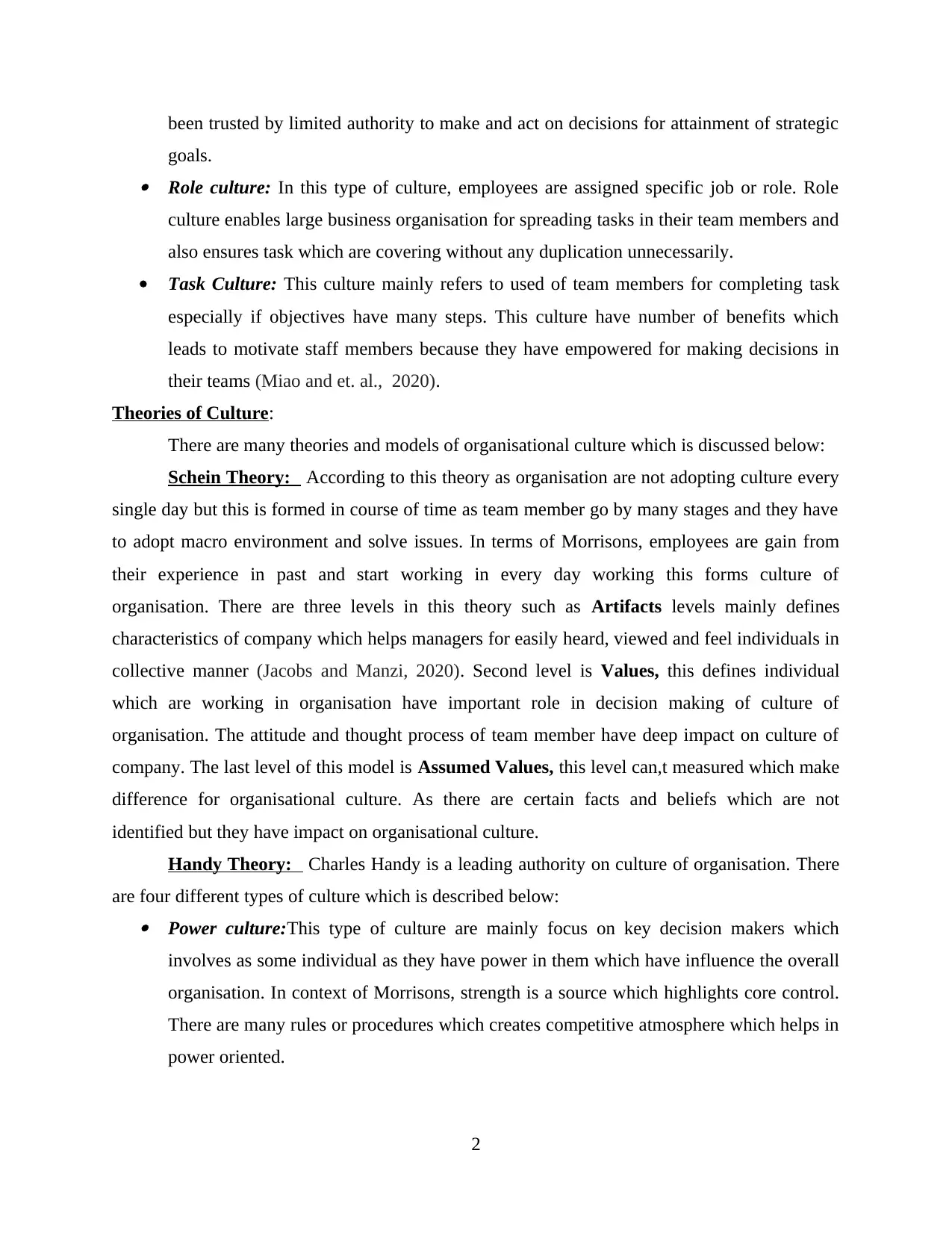
been trusted by limited authority to make and act on decisions for attainment of strategic
goals. Role culture: In this type of culture, employees are assigned specific job or role. Role
culture enables large business organisation for spreading tasks in their team members and
also ensures task which are covering without any duplication unnecessarily.
Task Culture: This culture mainly refers to used of team members for completing task
especially if objectives have many steps. This culture have number of benefits which
leads to motivate staff members because they have empowered for making decisions in
their teams (Miao and et. al., 2020).
Theories of Culture:
There are many theories and models of organisational culture which is discussed below:
Schein Theory: According to this theory as organisation are not adopting culture every
single day but this is formed in course of time as team member go by many stages and they have
to adopt macro environment and solve issues. In terms of Morrisons, employees are gain from
their experience in past and start working in every day working this forms culture of
organisation. There are three levels in this theory such as Artifacts levels mainly defines
characteristics of company which helps managers for easily heard, viewed and feel individuals in
collective manner (Jacobs and Manzi, 2020). Second level is Values, this defines individual
which are working in organisation have important role in decision making of culture of
organisation. The attitude and thought process of team member have deep impact on culture of
company. The last level of this model is Assumed Values, this level can,t measured which make
difference for organisational culture. As there are certain facts and beliefs which are not
identified but they have impact on organisational culture.
Handy Theory: Charles Handy is a leading authority on culture of organisation. There
are four different types of culture which is described below: Power culture:This type of culture are mainly focus on key decision makers which
involves as some individual as they have power in them which have influence the overall
organisation. In context of Morrisons, strength is a source which highlights core control.
There are many rules or procedures which creates competitive atmosphere which helps in
power oriented.
2
goals. Role culture: In this type of culture, employees are assigned specific job or role. Role
culture enables large business organisation for spreading tasks in their team members and
also ensures task which are covering without any duplication unnecessarily.
Task Culture: This culture mainly refers to used of team members for completing task
especially if objectives have many steps. This culture have number of benefits which
leads to motivate staff members because they have empowered for making decisions in
their teams (Miao and et. al., 2020).
Theories of Culture:
There are many theories and models of organisational culture which is discussed below:
Schein Theory: According to this theory as organisation are not adopting culture every
single day but this is formed in course of time as team member go by many stages and they have
to adopt macro environment and solve issues. In terms of Morrisons, employees are gain from
their experience in past and start working in every day working this forms culture of
organisation. There are three levels in this theory such as Artifacts levels mainly defines
characteristics of company which helps managers for easily heard, viewed and feel individuals in
collective manner (Jacobs and Manzi, 2020). Second level is Values, this defines individual
which are working in organisation have important role in decision making of culture of
organisation. The attitude and thought process of team member have deep impact on culture of
company. The last level of this model is Assumed Values, this level can,t measured which make
difference for organisational culture. As there are certain facts and beliefs which are not
identified but they have impact on organisational culture.
Handy Theory: Charles Handy is a leading authority on culture of organisation. There
are four different types of culture which is described below: Power culture:This type of culture are mainly focus on key decision makers which
involves as some individual as they have power in them which have influence the overall
organisation. In context of Morrisons, strength is a source which highlights core control.
There are many rules or procedures which creates competitive atmosphere which helps in
power oriented.
2
Paraphrase This Document
Need a fresh take? Get an instant paraphrase of this document with our AI Paraphraser
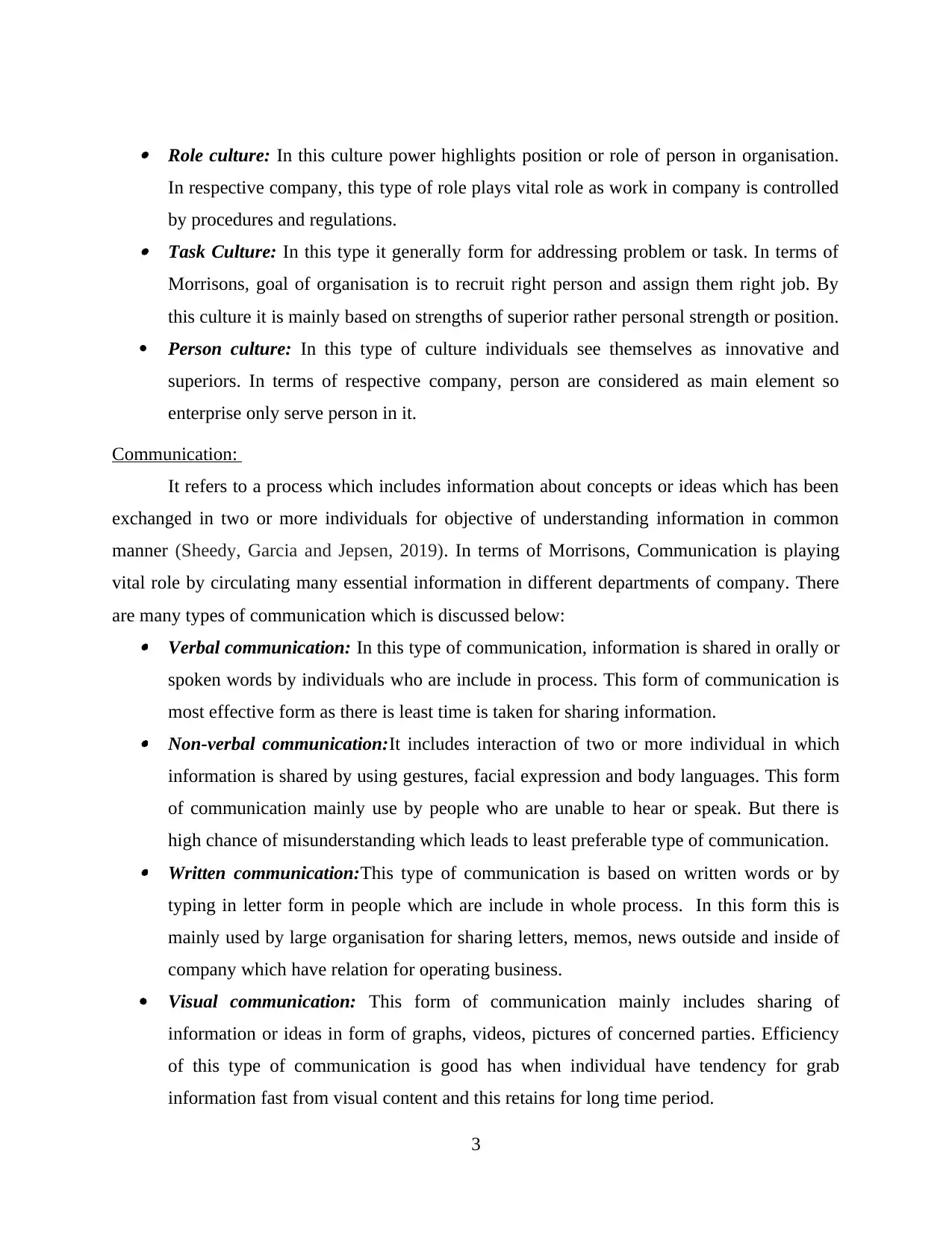
Role culture: In this culture power highlights position or role of person in organisation.
In respective company, this type of role plays vital role as work in company is controlled
by procedures and regulations. Task Culture: In this type it generally form for addressing problem or task. In terms of
Morrisons, goal of organisation is to recruit right person and assign them right job. By
this culture it is mainly based on strengths of superior rather personal strength or position.
Person culture: In this type of culture individuals see themselves as innovative and
superiors. In terms of respective company, person are considered as main element so
enterprise only serve person in it.
Communication:
It refers to a process which includes information about concepts or ideas which has been
exchanged in two or more individuals for objective of understanding information in common
manner (Sheedy, Garcia and Jepsen, 2019). In terms of Morrisons, Communication is playing
vital role by circulating many essential information in different departments of company. There
are many types of communication which is discussed below: Verbal communication: In this type of communication, information is shared in orally or
spoken words by individuals who are include in process. This form of communication is
most effective form as there is least time is taken for sharing information. Non-verbal communication:It includes interaction of two or more individual in which
information is shared by using gestures, facial expression and body languages. This form
of communication mainly use by people who are unable to hear or speak. But there is
high chance of misunderstanding which leads to least preferable type of communication. Written communication:This type of communication is based on written words or by
typing in letter form in people which are include in whole process. In this form this is
mainly used by large organisation for sharing letters, memos, news outside and inside of
company which have relation for operating business.
Visual communication: This form of communication mainly includes sharing of
information or ideas in form of graphs, videos, pictures of concerned parties. Efficiency
of this type of communication is good has when individual have tendency for grab
information fast from visual content and this retains for long time period.
3
In respective company, this type of role plays vital role as work in company is controlled
by procedures and regulations. Task Culture: In this type it generally form for addressing problem or task. In terms of
Morrisons, goal of organisation is to recruit right person and assign them right job. By
this culture it is mainly based on strengths of superior rather personal strength or position.
Person culture: In this type of culture individuals see themselves as innovative and
superiors. In terms of respective company, person are considered as main element so
enterprise only serve person in it.
Communication:
It refers to a process which includes information about concepts or ideas which has been
exchanged in two or more individuals for objective of understanding information in common
manner (Sheedy, Garcia and Jepsen, 2019). In terms of Morrisons, Communication is playing
vital role by circulating many essential information in different departments of company. There
are many types of communication which is discussed below: Verbal communication: In this type of communication, information is shared in orally or
spoken words by individuals who are include in process. This form of communication is
most effective form as there is least time is taken for sharing information. Non-verbal communication:It includes interaction of two or more individual in which
information is shared by using gestures, facial expression and body languages. This form
of communication mainly use by people who are unable to hear or speak. But there is
high chance of misunderstanding which leads to least preferable type of communication. Written communication:This type of communication is based on written words or by
typing in letter form in people which are include in whole process. In this form this is
mainly used by large organisation for sharing letters, memos, news outside and inside of
company which have relation for operating business.
Visual communication: This form of communication mainly includes sharing of
information or ideas in form of graphs, videos, pictures of concerned parties. Efficiency
of this type of communication is good has when individual have tendency for grab
information fast from visual content and this retains for long time period.
3
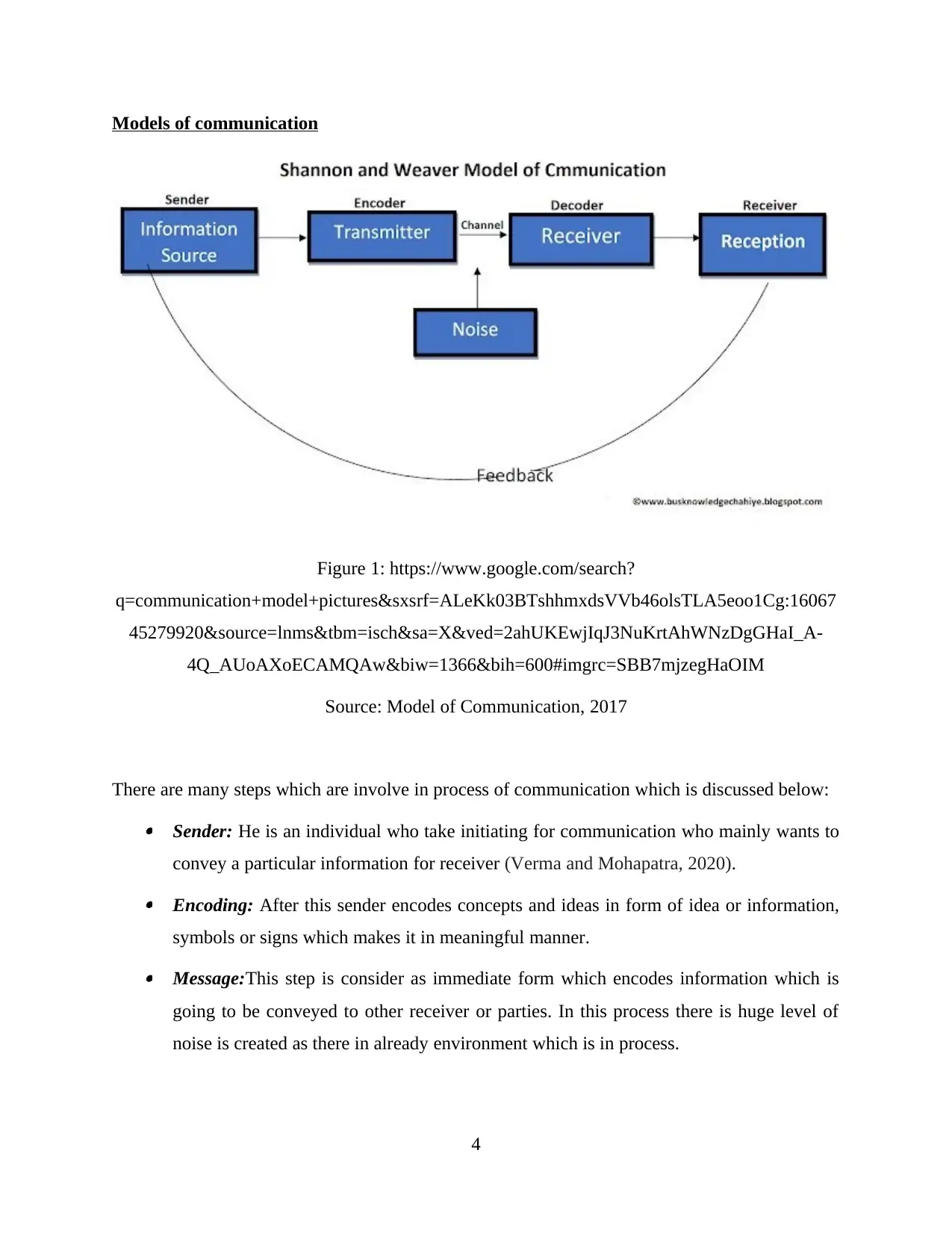
Models of communication
Figure 1: https://www.google.com/search?
q=communication+model+pictures&sxsrf=ALeKk03BTshhmxdsVVb46olsTLA5eoo1Cg:16067
45279920&source=lnms&tbm=isch&sa=X&ved=2ahUKEwjIqJ3NuKrtAhWNzDgGHaI_A-
4Q_AUoAXoECAMQAw&biw=1366&bih=600#imgrc=SBB7mjzegHaOIM
Source: Model of Communication, 2017
There are many steps which are involve in process of communication which is discussed below: Sender: He is an individual who take initiating for communication who mainly wants to
convey a particular information for receiver (Verma and Mohapatra, 2020). Encoding: After this sender encodes concepts and ideas in form of idea or information,
symbols or signs which makes it in meaningful manner. Message:This step is consider as immediate form which encodes information which is
going to be conveyed to other receiver or parties. In this process there is huge level of
noise is created as there in already environment which is in process.
4
Figure 1: https://www.google.com/search?
q=communication+model+pictures&sxsrf=ALeKk03BTshhmxdsVVb46olsTLA5eoo1Cg:16067
45279920&source=lnms&tbm=isch&sa=X&ved=2ahUKEwjIqJ3NuKrtAhWNzDgGHaI_A-
4Q_AUoAXoECAMQAw&biw=1366&bih=600#imgrc=SBB7mjzegHaOIM
Source: Model of Communication, 2017
There are many steps which are involve in process of communication which is discussed below: Sender: He is an individual who take initiating for communication who mainly wants to
convey a particular information for receiver (Verma and Mohapatra, 2020). Encoding: After this sender encodes concepts and ideas in form of idea or information,
symbols or signs which makes it in meaningful manner. Message:This step is consider as immediate form which encodes information which is
going to be conveyed to other receiver or parties. In this process there is huge level of
noise is created as there in already environment which is in process.
4
⊘ This is a preview!⊘
Do you want full access?
Subscribe today to unlock all pages.

Trusted by 1+ million students worldwide
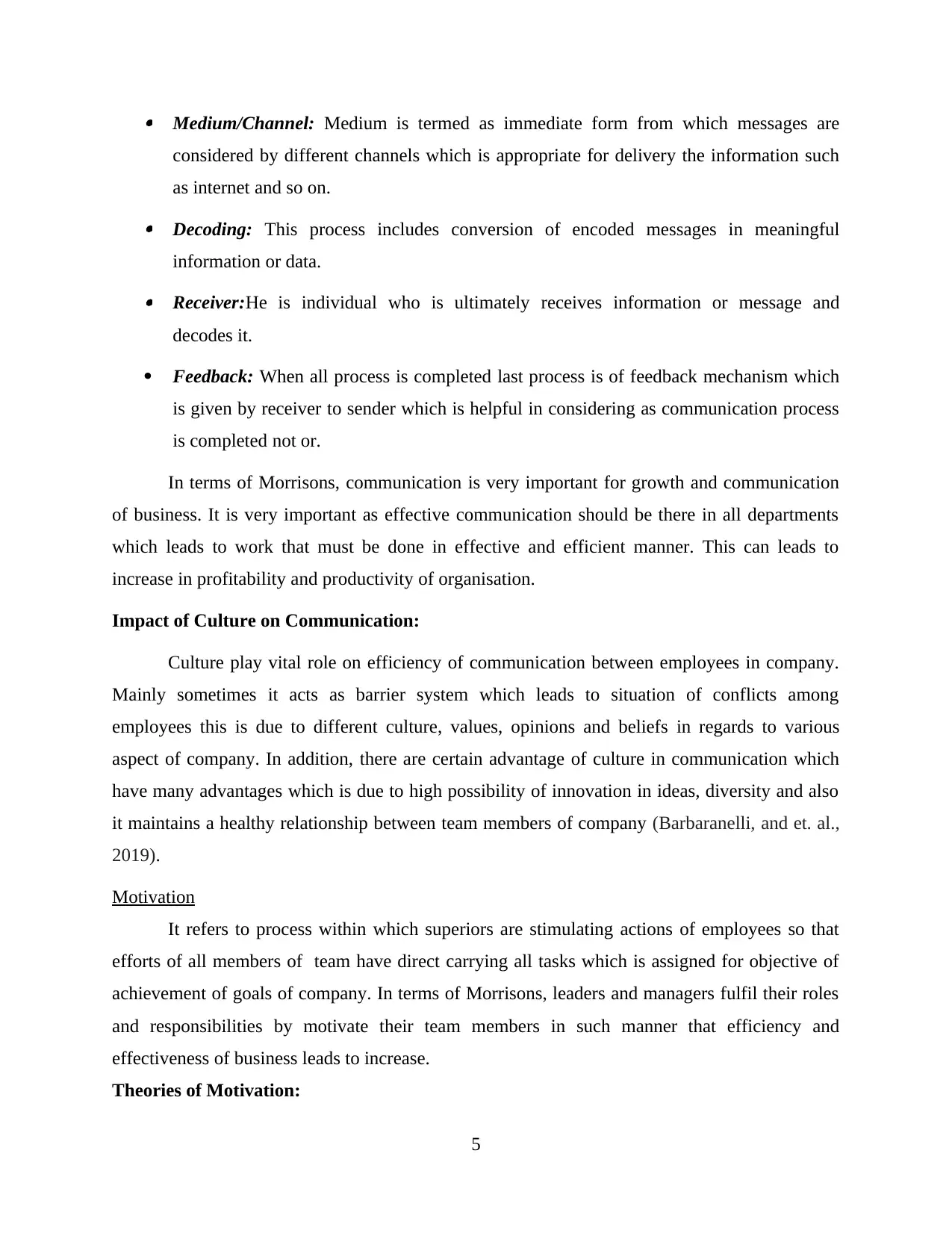
Medium/Channel: Medium is termed as immediate form from which messages are
considered by different channels which is appropriate for delivery the information such
as internet and so on. Decoding: This process includes conversion of encoded messages in meaningful
information or data. Receiver:He is individual who is ultimately receives information or message and
decodes it.
Feedback: When all process is completed last process is of feedback mechanism which
is given by receiver to sender which is helpful in considering as communication process
is completed not or.
In terms of Morrisons, communication is very important for growth and communication
of business. It is very important as effective communication should be there in all departments
which leads to work that must be done in effective and efficient manner. This can leads to
increase in profitability and productivity of organisation.
Impact of Culture on Communication:
Culture play vital role on efficiency of communication between employees in company.
Mainly sometimes it acts as barrier system which leads to situation of conflicts among
employees this is due to different culture, values, opinions and beliefs in regards to various
aspect of company. In addition, there are certain advantage of culture in communication which
have many advantages which is due to high possibility of innovation in ideas, diversity and also
it maintains a healthy relationship between team members of company (Barbaranelli, and et. al.,
2019).
Motivation
It refers to process within which superiors are stimulating actions of employees so that
efforts of all members of team have direct carrying all tasks which is assigned for objective of
achievement of goals of company. In terms of Morrisons, leaders and managers fulfil their roles
and responsibilities by motivate their team members in such manner that efficiency and
effectiveness of business leads to increase.
Theories of Motivation:
5
considered by different channels which is appropriate for delivery the information such
as internet and so on. Decoding: This process includes conversion of encoded messages in meaningful
information or data. Receiver:He is individual who is ultimately receives information or message and
decodes it.
Feedback: When all process is completed last process is of feedback mechanism which
is given by receiver to sender which is helpful in considering as communication process
is completed not or.
In terms of Morrisons, communication is very important for growth and communication
of business. It is very important as effective communication should be there in all departments
which leads to work that must be done in effective and efficient manner. This can leads to
increase in profitability and productivity of organisation.
Impact of Culture on Communication:
Culture play vital role on efficiency of communication between employees in company.
Mainly sometimes it acts as barrier system which leads to situation of conflicts among
employees this is due to different culture, values, opinions and beliefs in regards to various
aspect of company. In addition, there are certain advantage of culture in communication which
have many advantages which is due to high possibility of innovation in ideas, diversity and also
it maintains a healthy relationship between team members of company (Barbaranelli, and et. al.,
2019).
Motivation
It refers to process within which superiors are stimulating actions of employees so that
efforts of all members of team have direct carrying all tasks which is assigned for objective of
achievement of goals of company. In terms of Morrisons, leaders and managers fulfil their roles
and responsibilities by motivate their team members in such manner that efficiency and
effectiveness of business leads to increase.
Theories of Motivation:
5
Paraphrase This Document
Need a fresh take? Get an instant paraphrase of this document with our AI Paraphraser
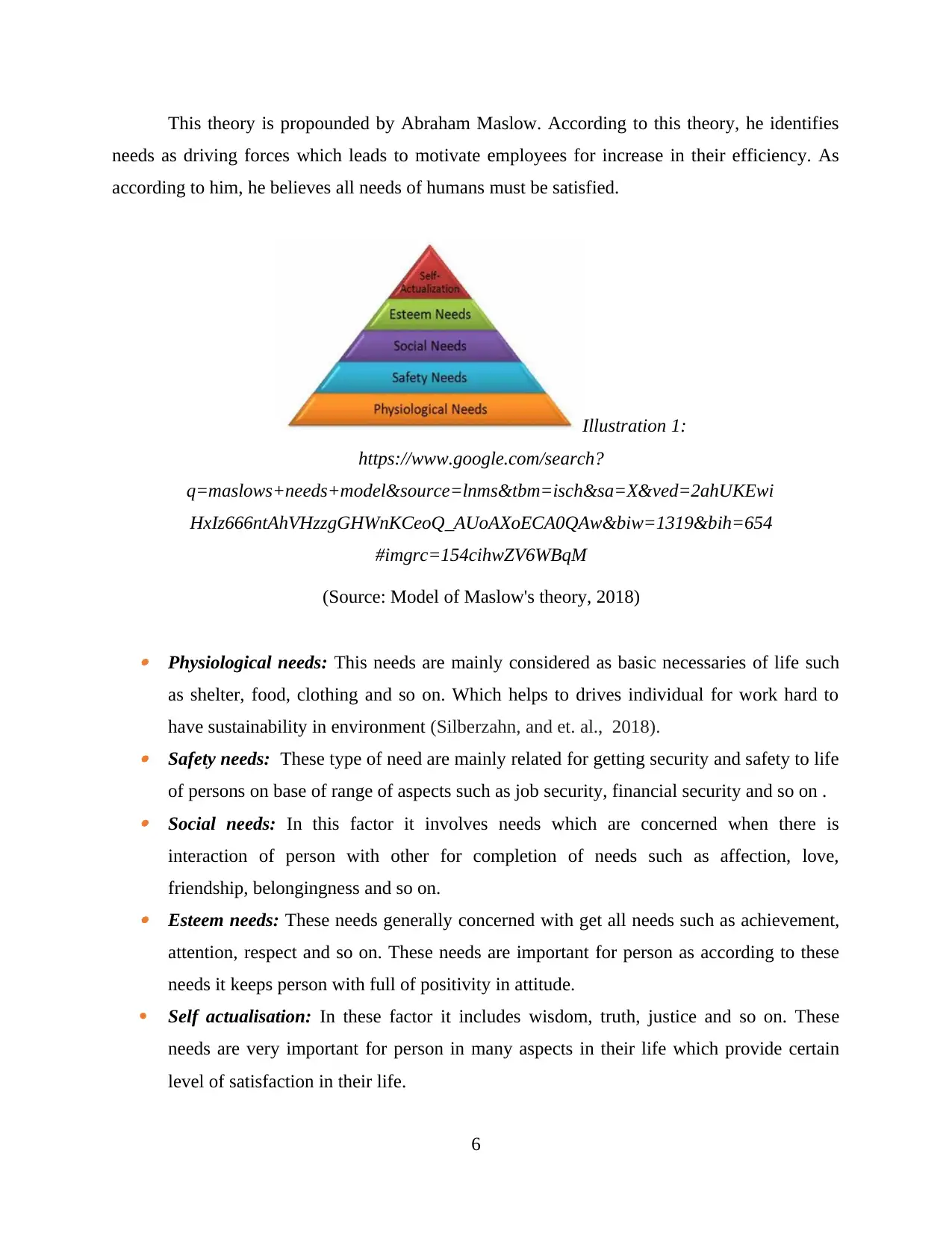
This theory is propounded by Abraham Maslow. According to this theory, he identifies
needs as driving forces which leads to motivate employees for increase in their efficiency. As
according to him, he believes all needs of humans must be satisfied.
Physiological needs: This needs are mainly considered as basic necessaries of life such
as shelter, food, clothing and so on. Which helps to drives individual for work hard to
have sustainability in environment (Silberzahn, and et. al., 2018). Safety needs: These type of need are mainly related for getting security and safety to life
of persons on base of range of aspects such as job security, financial security and so on . Social needs: In this factor it involves needs which are concerned when there is
interaction of person with other for completion of needs such as affection, love,
friendship, belongingness and so on. Esteem needs: These needs generally concerned with get all needs such as achievement,
attention, respect and so on. These needs are important for person as according to these
needs it keeps person with full of positivity in attitude.
Self actualisation: In these factor it includes wisdom, truth, justice and so on. These
needs are very important for person in many aspects in their life which provide certain
level of satisfaction in their life.
6
Illustration 1:
https://www.google.com/search?
q=maslows+needs+model&source=lnms&tbm=isch&sa=X&ved=2ahUKEwi
HxIz666ntAhVHzzgGHWnKCeoQ_AUoAXoECA0QAw&biw=1319&bih=654
#imgrc=154cihwZV6WBqM
(Source: Model of Maslow's theory, 2018)
needs as driving forces which leads to motivate employees for increase in their efficiency. As
according to him, he believes all needs of humans must be satisfied.
Physiological needs: This needs are mainly considered as basic necessaries of life such
as shelter, food, clothing and so on. Which helps to drives individual for work hard to
have sustainability in environment (Silberzahn, and et. al., 2018). Safety needs: These type of need are mainly related for getting security and safety to life
of persons on base of range of aspects such as job security, financial security and so on . Social needs: In this factor it involves needs which are concerned when there is
interaction of person with other for completion of needs such as affection, love,
friendship, belongingness and so on. Esteem needs: These needs generally concerned with get all needs such as achievement,
attention, respect and so on. These needs are important for person as according to these
needs it keeps person with full of positivity in attitude.
Self actualisation: In these factor it includes wisdom, truth, justice and so on. These
needs are very important for person in many aspects in their life which provide certain
level of satisfaction in their life.
6
Illustration 1:
https://www.google.com/search?
q=maslows+needs+model&source=lnms&tbm=isch&sa=X&ved=2ahUKEwi
HxIz666ntAhVHzzgGHWnKCeoQ_AUoAXoECA0QAw&biw=1319&bih=654
#imgrc=154cihwZV6WBqM
(Source: Model of Maslow's theory, 2018)

In terms of Morrisons, team members seek all these above needs as this company is
reputed company which have capability of offering these types of needs by giving them good
working environment. Regulations and rules which leads to growth in company.
B. Herzberg's Two Factor
This theory was invented by Frederick Herzberg in 1959. According to him, there are
certain aspects or factors which helps in causes satisfaction in employees but on other side there
are many factors which causes dissatisfaction in employees (Belschak-Jacobs, 2018). There are
two factors which are discussed below: Hygiene factors: These forces mainly influences motivation level of team members as
working environment is not healthy for employees this have outcome as lowering
satisfaction level of team members. These factors involves such as incentives, healthy
working environment, pay and so on.
Motivation Factors: In this theory factors are includes which have satisfaction in
employees as by this team members can identify development of company has been
enhance by efforts which are making by all individuals. In this theory, factors involves
are better work, achievement, increased quality, recognition (Effron and Raj, 2020.).
In terms of Morrisons, there is high motivation factor as there is benefits which is being
provide to team members as they are of great quality by paying them good salary which helps to
motivate them and satisfy their needs by this they work in effective manner.
Impact of culture on motivation:
Culture paly important role in Morrisons for motivate team members of company ass
managers and leaders have ability to link the culture with motivation terms by analysing and
identifying characteristics, values and attitudes of various people. By this it leads to help
superiors by making strategies for deal with diversities which leads to stimulate actions of all
employees on organisational goals.
Role of culture in overall success of organisation.
There are many benefits which is being offered to company by culture which is discussed below:
It helps by understanding threats by entity in their company among customers and
employees which have link with each other. In terms of Morrisons, company is very
concerned for smooth functioning of business organisation, so for this company have to
keep works on their technology factors as by involving innovation in new technology,
7
reputed company which have capability of offering these types of needs by giving them good
working environment. Regulations and rules which leads to growth in company.
B. Herzberg's Two Factor
This theory was invented by Frederick Herzberg in 1959. According to him, there are
certain aspects or factors which helps in causes satisfaction in employees but on other side there
are many factors which causes dissatisfaction in employees (Belschak-Jacobs, 2018). There are
two factors which are discussed below: Hygiene factors: These forces mainly influences motivation level of team members as
working environment is not healthy for employees this have outcome as lowering
satisfaction level of team members. These factors involves such as incentives, healthy
working environment, pay and so on.
Motivation Factors: In this theory factors are includes which have satisfaction in
employees as by this team members can identify development of company has been
enhance by efforts which are making by all individuals. In this theory, factors involves
are better work, achievement, increased quality, recognition (Effron and Raj, 2020.).
In terms of Morrisons, there is high motivation factor as there is benefits which is being
provide to team members as they are of great quality by paying them good salary which helps to
motivate them and satisfy their needs by this they work in effective manner.
Impact of culture on motivation:
Culture paly important role in Morrisons for motivate team members of company ass
managers and leaders have ability to link the culture with motivation terms by analysing and
identifying characteristics, values and attitudes of various people. By this it leads to help
superiors by making strategies for deal with diversities which leads to stimulate actions of all
employees on organisational goals.
Role of culture in overall success of organisation.
There are many benefits which is being offered to company by culture which is discussed below:
It helps by understanding threats by entity in their company among customers and
employees which have link with each other. In terms of Morrisons, company is very
concerned for smooth functioning of business organisation, so for this company have to
keep works on their technology factors as by involving innovation in new technology,
7
⊘ This is a preview!⊘
Do you want full access?
Subscribe today to unlock all pages.

Trusted by 1+ million students worldwide
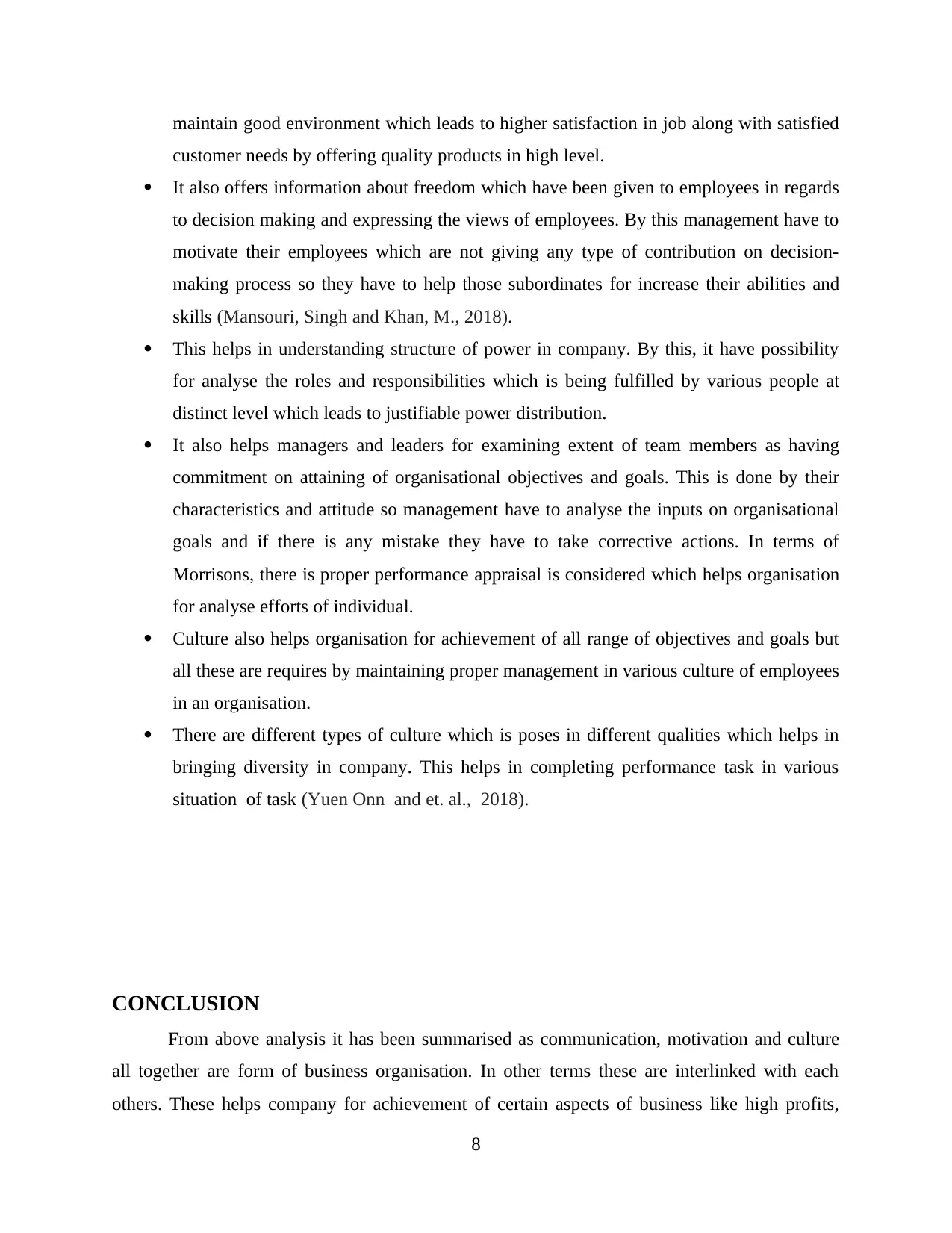
maintain good environment which leads to higher satisfaction in job along with satisfied
customer needs by offering quality products in high level.
It also offers information about freedom which have been given to employees in regards
to decision making and expressing the views of employees. By this management have to
motivate their employees which are not giving any type of contribution on decision-
making process so they have to help those subordinates for increase their abilities and
skills (Mansouri, Singh and Khan, M., 2018).
This helps in understanding structure of power in company. By this, it have possibility
for analyse the roles and responsibilities which is being fulfilled by various people at
distinct level which leads to justifiable power distribution.
It also helps managers and leaders for examining extent of team members as having
commitment on attaining of organisational objectives and goals. This is done by their
characteristics and attitude so management have to analyse the inputs on organisational
goals and if there is any mistake they have to take corrective actions. In terms of
Morrisons, there is proper performance appraisal is considered which helps organisation
for analyse efforts of individual.
Culture also helps organisation for achievement of all range of objectives and goals but
all these are requires by maintaining proper management in various culture of employees
in an organisation.
There are different types of culture which is poses in different qualities which helps in
bringing diversity in company. This helps in completing performance task in various
situation of task (Yuen Onn and et. al., 2018).
CONCLUSION
From above analysis it has been summarised as communication, motivation and culture
all together are form of business organisation. In other terms these are interlinked with each
others. These helps company for achievement of certain aspects of business like high profits,
8
customer needs by offering quality products in high level.
It also offers information about freedom which have been given to employees in regards
to decision making and expressing the views of employees. By this management have to
motivate their employees which are not giving any type of contribution on decision-
making process so they have to help those subordinates for increase their abilities and
skills (Mansouri, Singh and Khan, M., 2018).
This helps in understanding structure of power in company. By this, it have possibility
for analyse the roles and responsibilities which is being fulfilled by various people at
distinct level which leads to justifiable power distribution.
It also helps managers and leaders for examining extent of team members as having
commitment on attaining of organisational objectives and goals. This is done by their
characteristics and attitude so management have to analyse the inputs on organisational
goals and if there is any mistake they have to take corrective actions. In terms of
Morrisons, there is proper performance appraisal is considered which helps organisation
for analyse efforts of individual.
Culture also helps organisation for achievement of all range of objectives and goals but
all these are requires by maintaining proper management in various culture of employees
in an organisation.
There are different types of culture which is poses in different qualities which helps in
bringing diversity in company. This helps in completing performance task in various
situation of task (Yuen Onn and et. al., 2018).
CONCLUSION
From above analysis it has been summarised as communication, motivation and culture
all together are form of business organisation. In other terms these are interlinked with each
others. These helps company for achievement of certain aspects of business like high profits,
8
Paraphrase This Document
Need a fresh take? Get an instant paraphrase of this document with our AI Paraphraser
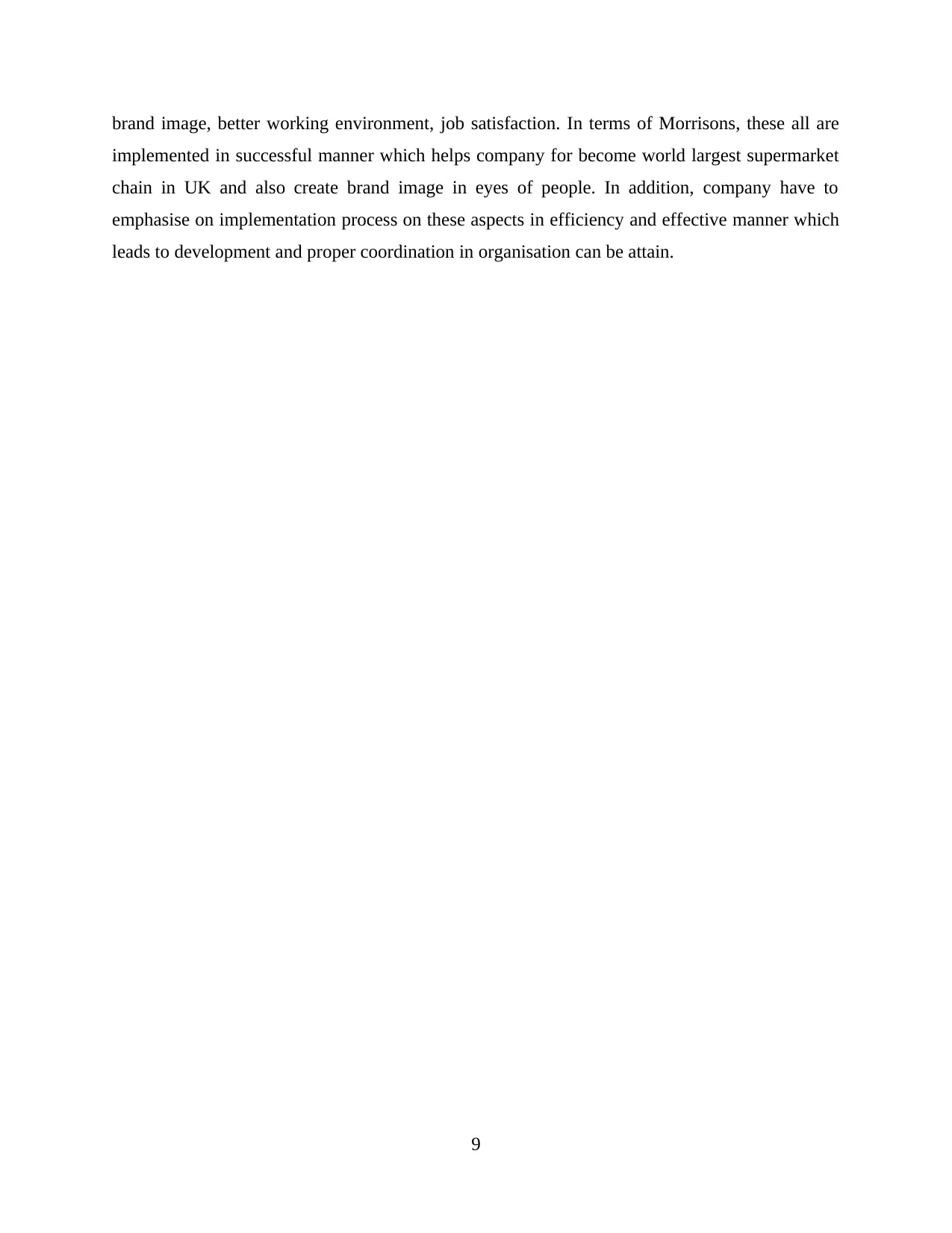
brand image, better working environment, job satisfaction. In terms of Morrisons, these all are
implemented in successful manner which helps company for become world largest supermarket
chain in UK and also create brand image in eyes of people. In addition, company have to
emphasise on implementation process on these aspects in efficiency and effective manner which
leads to development and proper coordination in organisation can be attain.
9
implemented in successful manner which helps company for become world largest supermarket
chain in UK and also create brand image in eyes of people. In addition, company have to
emphasise on implementation process on these aspects in efficiency and effective manner which
leads to development and proper coordination in organisation can be attain.
9

REFERENCES
Books and Journals
Alasad, H., 2020.The Impact of Agile Processes on Organisational Behaviour Within Current
Banking Practice(Doctoral dissertation, Auckland University of Technology).
Balwant, P.T., 2018. The meaning of student engagement and disengagement in the classroom
context: Lessons from organisational behaviour.Journal of Further and Higher
Education,42(3), pp.389-401.
Barbaranelli, C. and et. al., 2019. Positivity and behaviour: the mediating role of self-efficacy in
organisational and educational settings.Journal of Happiness Studies,20(3), pp.707-727.
Belschak-Jacobs, G., 2018. Organisational Behaviour and Culture.
Effron, D.A. and Raj, M., 2020. Misinformation and morality: encountering fake-news headlines
makes them seem less unethical to publish and share.Psychological science,31(1),
pp.75-87.
Griffin, R.W. and et. al., 2020.Organisational Behaviour: Engaging People and Organisations.
Cengage AU.
Jacobs, K. and Manzi, T., 2020. Conceptualising ‘financialisation’: governance, organisational
behaviour and social interaction in UK housing. International Journal of Housing
Policy,20(2), pp.184-202.
Mansouri, A.A.A., Singh, S.K. and Khan, M., 2018. Role of organisational culture, leadership
and organisational citizenship behaviour on knowledge management.International
Journal of Knowledge Management Studies,9(2), pp.129-143.
Miao, Q. and et. al., 2020. Ethical Leadership and Unethical Pro‐Organisational Behaviour: The
Mediating Mechanism of Reflective Moral Attentiveness.Applied Psychology,69(3),
pp.834-853.
Sheedy, E., Garcia, P. and Jepsen, D., 2019. The Role of Risk Climate and Ethical Self-interest
Climate in Predicting Unethical Pro-organisational Behaviour.Journal of Business
Ethics, pp.1-20.
Silberzahn, R. and et. al., 2018. Many analysts, one data set: Making transparent how variations
in analytic choices affect results. Advances in Methods and Practices in Psychological
Science,1(3), pp.337-356.
Verma, P. and Mohapatra, S., 2020. Strong Identification, Weak Ideology, Organisational
Culture or All: Unethical Pro-organisational Behaviour in India. InWar, Peace and
Organizational Ethics. Emerald Publishing Limited.
Yuen Onn, C. and et. al., 2018. The mediating effect of trust on the dimensionality of
organisational justice and organisational citizenship behaviour amongst teachers in
Malaysia.Educational Psychology,38(8), pp.1010-1031.
10
Books and Journals
Alasad, H., 2020.The Impact of Agile Processes on Organisational Behaviour Within Current
Banking Practice(Doctoral dissertation, Auckland University of Technology).
Balwant, P.T., 2018. The meaning of student engagement and disengagement in the classroom
context: Lessons from organisational behaviour.Journal of Further and Higher
Education,42(3), pp.389-401.
Barbaranelli, C. and et. al., 2019. Positivity and behaviour: the mediating role of self-efficacy in
organisational and educational settings.Journal of Happiness Studies,20(3), pp.707-727.
Belschak-Jacobs, G., 2018. Organisational Behaviour and Culture.
Effron, D.A. and Raj, M., 2020. Misinformation and morality: encountering fake-news headlines
makes them seem less unethical to publish and share.Psychological science,31(1),
pp.75-87.
Griffin, R.W. and et. al., 2020.Organisational Behaviour: Engaging People and Organisations.
Cengage AU.
Jacobs, K. and Manzi, T., 2020. Conceptualising ‘financialisation’: governance, organisational
behaviour and social interaction in UK housing. International Journal of Housing
Policy,20(2), pp.184-202.
Mansouri, A.A.A., Singh, S.K. and Khan, M., 2018. Role of organisational culture, leadership
and organisational citizenship behaviour on knowledge management.International
Journal of Knowledge Management Studies,9(2), pp.129-143.
Miao, Q. and et. al., 2020. Ethical Leadership and Unethical Pro‐Organisational Behaviour: The
Mediating Mechanism of Reflective Moral Attentiveness.Applied Psychology,69(3),
pp.834-853.
Sheedy, E., Garcia, P. and Jepsen, D., 2019. The Role of Risk Climate and Ethical Self-interest
Climate in Predicting Unethical Pro-organisational Behaviour.Journal of Business
Ethics, pp.1-20.
Silberzahn, R. and et. al., 2018. Many analysts, one data set: Making transparent how variations
in analytic choices affect results. Advances in Methods and Practices in Psychological
Science,1(3), pp.337-356.
Verma, P. and Mohapatra, S., 2020. Strong Identification, Weak Ideology, Organisational
Culture or All: Unethical Pro-organisational Behaviour in India. InWar, Peace and
Organizational Ethics. Emerald Publishing Limited.
Yuen Onn, C. and et. al., 2018. The mediating effect of trust on the dimensionality of
organisational justice and organisational citizenship behaviour amongst teachers in
Malaysia.Educational Psychology,38(8), pp.1010-1031.
10
⊘ This is a preview!⊘
Do you want full access?
Subscribe today to unlock all pages.

Trusted by 1+ million students worldwide
1 out of 12
Related Documents
Your All-in-One AI-Powered Toolkit for Academic Success.
+13062052269
info@desklib.com
Available 24*7 on WhatsApp / Email
![[object Object]](/_next/static/media/star-bottom.7253800d.svg)
Unlock your academic potential
Copyright © 2020–2025 A2Z Services. All Rights Reserved. Developed and managed by ZUCOL.


